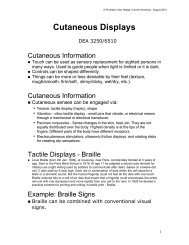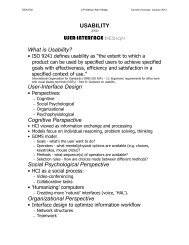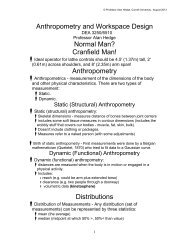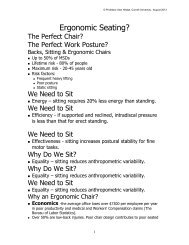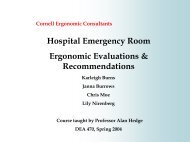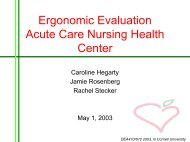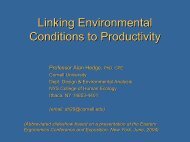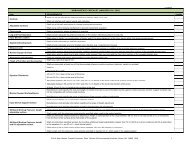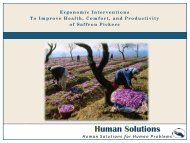Systems Thinking - Cornell University Ergonomics Web
Systems Thinking - Cornell University Ergonomics Web
Systems Thinking - Cornell University Ergonomics Web
You also want an ePaper? Increase the reach of your titles
YUMPU automatically turns print PDFs into web optimized ePapers that Google loves.
© Professor Alan Hedge, <strong>Cornell</strong> <strong>University</strong>, August 2013<strong>Systems</strong> <strong>Thinking</strong>DEA 3250/6510Professor Alan Hedge<strong>Systems</strong> <strong>Ergonomics</strong>• Work Environment1. Physical demands (e.g. lifting limits)2. Skill demands (e.g. typing at 100 wpm)3. Risk demands (e.g. driving on ice)4. Time demands (e.g. deadlines)• Physical Environment1. physical agents (e.g. noise, vibration)2. chemical agents (e.g. air pollutants)3. biological agents (e.g. allergens, airborne diseases)<strong>Systems</strong> <strong>Ergonomics</strong>• Technology1. Product design (anthropometrics, biomechanics)2. Hardware Interface design3. Software interface design• Psychosocial Environment1. Social (e.g. teams)2. Cultural (e.g. motivators)3. Lifestyle (e.g. quality of work life)Ergonomic Considerations• Physical factors• ambient conditions; objects (tools, furniture, etc.)• Biological factors• body dimensions, body capabilities, physiological processes• Psychological factors• mental workload, information processing, training, motivation• Work factors• job demands (time, rate, etc.), job design• Organizational factors• organization type/climate, management regimes1
© Professor Alan Hedge, <strong>Cornell</strong> <strong>University</strong>, August 2013Objectives of <strong>Ergonomics</strong> Enhance the effectiveness and efficiency of work:• ease of use, reliability, productivity,• reduce errors Enhance certain desirable human values:• enhance safety, satisfaction, comfort, quality of work life• reduce fatigue, stress, accidents<strong>Systems</strong> <strong>Thinking</strong>" For every complex problem there is always a simple solution.And it is wrong. "H.L.MenckenThree Mile Island,PWRs at Harrisburg, PA (~230 miles away).Pressurized Water Reactor (PWR)• In PWRs, the reactor core is in a massive steel bottle (Pressure Vessel). Three water coolant loops moveheat from the reactor core to the turbines which drive the generators.• Reactor Coolant loop passes water among the fuel assemblies in the core at several hundred °F, under>2,000 psi pressure to prevent the water from boiling into steam.• Hot water from the pressure vessel enters steam generator (a heat exchanger).• Secondary water passes around primary feed, and under far lower pressure it flashes quickly intosteam.• Primary coolant constantly recirculated by RC pumps. Each pump at TMI was 2 stories high, 9,000 hp,and circulated 360,000 gallons per minute!PWR Pressurizer• The pressurizer connects to the primary coolant loop. It is normally about half full of water, and half full ofsteam.• A tube at the bottom connects to the reactor vessel, and at the top are relief valves which open to protectthe system when too much pressure builds up.• Relief valve (RV) designed to always open (but didn't always close).• Block valve (BV) manually operated so that it could be closed to prevent coolant loss.• For safety, all components of the primary cooling loop are located a huge concrete structure(containment dome) with walls 12' thick, and reinforced with high-strength steel. It is designed towithstand the direct impact of a jet airliner, and can withstand very high inside pressures.TMI-2: a 'normal' night?• March 27, 1979 - Three Mile Island generating 97% of rated 1,000 megawattcapacity.• 11pm night shift - supervisor + 2 trained operators in control room, 14 auxiliaryoperators scattered around the plant.2
© Professor Alan Hedge, <strong>Cornell</strong> <strong>University</strong>, August 2013• Almost 4am - 2 men were cleaning a feedwater polisher (large tank, 1 of 8,filled with resin beads to remove contaminants from feedwater).Old beadsformed a 'clot' (usually dislodged by bursts of compressed air).• TMI-2 had 2 compressed air systems, 1 of which controlled all pneumaticallyoperated valves and controls (instrument air).• BUT sometime during the night, someone mistakenly connected a rubber hosebetween this instrument air system and a water line (area was dark, fittingsalmost identical and poorly labeled).TMI-2 : the incident starts!• 3:57am - air+water mixture reached valve control piping - feedwater valvesslammed shut. Water hammer occurred. Control room floor shuddered. Violentshock tore out valve controls, ruptured feedwater pump casing and shatteredfeedwater pipes. Within seconds, entire auxiliary building awash with scaldingwater and filled with water vapor.• Plant's automatic control systems tripped the steam turbines and openedbypass valves to dump steam from the generator to the condenser.• BUT the condensor had a design flaw - sudden burst of steam blew water intothe condensor pump which tripped off as planned and steam was dumped intothe atmosphere with a deafening roar!TMI-2 : now you see it don't you?• With no cooling feedwater, reactor core temperature and pressure increased.Reactor tripped and control rods were inserted.• To help cool the core, 3 emergency feedwater pumps (2 electric + 1 steam)started automatically.• BUT during routine maintenance 1 week previously the water supply blockvalves had been closed and not re-opened.• Pumps were running at full speed but delivering no feedwater to the core. Lossof feedwater was indicated by a warning light in the control room.• BUT an adjacent yellow maintenance tag attached to a nearby switch coveredthe light.• The 1st item on the emergency checklist - "Verify emergency feed" wasoverlooked, and operators erroneously assumed water was flowing.TMI-2 : what you don't know could kill you?• As heat and pressure increased a relief valve opened to vent steam to thequench tank, and failed to close.• BUT the operators didn't realize that the absence of a bright indicator light inthe control only signaled that the valve had been commanded to close, not thatit had closed!• Primary loop temperature and pressure continued to soar. Eventually themaintenance tag was noticed and removed, revealing a red warning light. Theoperators opened the emergency feedwater valves, and the temperature riseslowed - temporarily.3
© Professor Alan Hedge, <strong>Cornell</strong> <strong>University</strong>, August 2013• As cold water entered the superhot primary system, steam bubbles wereformed. The main coolant RC pumps had to be shut down to avoid themvibrating to pieces and spilling primary coolant. Normally, convection currentswould have continued cooling the core.TM-2 : to err is human?• BUT steam bubbles in the pipes prevented normal convection. There were noindicators for this condition.• A large steam bubble formed over the top of the core and core meltdownbegan.• Eventually the supervisor suspected that a relief valve must be stuck open. Heasked an operator for a temperature reading at the valve outlet.• BUT the operator read the wrong display and reported that the temperaturewas normal.• Eventually, steam flowing at 1,000 pounds per minute ruptured a safety diskand overflowed into the containment building, flooding this with radioactivewater. All radiation alarms went off simultaneously.• At 6:00 am the day shift arrived.TMI-2 : in the light of day.• The day shift engineer realized that the relief valve must be stuck open, andclosed this, but reactor core pressure began to rise again. Operators looked tothe computer printouts for answers.• BUT thousands of alarms had been registered and the printer was hoursbehind reality. Also, software designers had never envisaged temperaturesanywhere that would be > 700°F (actually in places they exceeded 10,000 °F)and the software just printed question marks!• The fuel rods were clad in Zirconium. When exposed to steam this reacts andgenerates hydrogen. A hydrogen bubble began to form in the core.• A relay spark ignited the first hydrogen bubble, which exploded with the forceof a 1,000 lb bomb. Fortunately, the containment building held.TMI-2 : you can trust the politicians.• 15 hours after the start of the incident, engineers managed to restart one ofthe reactor core pumps, and finally the core began to properly cool.• March 30, 1979, 3 days after the incident, the governor recommend theevacuation of all pregnant women and preschool aged children. Schools wereclosed in the area and the governor ordered people to stay indoors.• April 1 (4 days later) - President Carter visited TMI and declared the reactorsafe and the incident 'over'. In truth, at this time a second hydrogen bubblehad formed and also oxygen was being released (at 5% this would be highlyexplosive). Oxygen was at 5% for over 24 hours!• Eventually, through the use of recombiner units, steam, hydrogen and oxygenwere removed from the core and the bubble collapsed.4
© Professor Alan Hedge, <strong>Cornell</strong> <strong>University</strong>, August 2013TMI-2 : the aftermath• All the 36,000 nuclear fuel rods in the core were damaged or destroyed. Coretemperature had reached 4,300°F (uranium melts at 5,000 °F).• Approximately 700,000 gallons of radioactive cooling water were spilled ontothe floor of the reactor building. To control this excessive quantity of water,400,000 gallons of radioactive water were released into the SusquehannaRiver.• Thousands of Curies of radioactive noble gases were released into theatmosphere. The last major venting was in 1981.• Some radioactive materials even managed to pass through the walls of theplant.TMI-2 : the lessons, the costs?• The TMI incident is characterized by poor human factors design of theinformation displays (from lights to software) and controls, and by frequenthuman error.• The decision to evacuate was controversial. Many experts insisted that therewas no threat to the public health and such evacuation orders would causepublic panic. It didn't!• The cleanup of the accident lasted to 1993. On Dec. 28 the plant was placedon monitored storage.• TMI will now be in 'safe storage' by 2005!• TMI will be decommissioned when the other reactor on Three Mile Island (TMI-1) is taken out of service. TMI unit 1 will lose its operational license on May 18,2008.Forensic Human Factors• Accident analysis• Historical data• Observational data• Accident reconstruction• Critical Incident Analysis• Near misses• Deliberate near failure• Error Analysis• Overload• Environment demands• Cognitive failures• Human Reliability Analysis<strong>Systems</strong> <strong>Thinking</strong>" The world we have made as a result of the level of thinking wehave done thus far creates problems that we cannot solve at the5
© Professor Alan Hedge, <strong>Cornell</strong> <strong>University</strong>, August 2013same level (of consciousness) at which we have created them....We shall require a substantially new manner of thinking ifhumankind is to survive. "Albert Einstein<strong>Systems</strong> <strong>Thinking</strong>‣ <strong>Systems</strong> thinking involves 'seeing' inter-connections andrelationships, the whole picture as well as the component parts.‣ <strong>Systems</strong> thinking provides key insights for the management ofcomplexity.<strong>Ergonomics</strong> and <strong>Systems</strong> <strong>Thinking</strong>‣ The concept of a system is fundamental to ergonomics‣ “A system is an entity that exists to carry out some purpose” (Bailey, 1982)‣ “A system is an organized or complex whole: an assemblage or combination ofthings or parts forming a complex, unitary whole.” (von Bertalanffy, ~1935)‣ Human-Machine system - “A system is an interacting combination, at any levelof complexity, of people, materials, tools, machines, software, facilities andprocedures designed to work together for some common purpose.” (Chapanis,1996, p.22)System Goals• Mission-oriented systems‣ Needs of personnel are subordinated to the goals of the system(e.g. mission to the moon).• Service-oriented systems‣ Needs of the clients/users are part of the goals of the system(e.g. hotel).Types of <strong>Systems</strong>• Manual systems• physical aids that are coupled to the operator (e.g. hand tools)• Mechanical systems (semiautomatic)• Operator uses controls to directly determine machine function(e.g. car)• Automated systems• Operator uses supervisory control to monitor system6
© Professor Alan Hedge, <strong>Cornell</strong> <strong>University</strong>, August 2013performance (e.g. robotic assembly line)System Characteristics• <strong>Systems</strong> are Purposive• Every system has a purpose (objective, goal).• E.g. <strong>University</strong> goals include:• Education• Socialization• Skills• Research• Administration• Recruitment• Financial• EmploymentSystem Characteristics• <strong>Systems</strong> can be Hierarchical• Subsystems are parts of larger systems. In studying any system.• Defining where system analysis starts and ends requiresdecisions on:• System boundaries - what is and isn’t part of the system (not necessarilyany right or wrong answers). Decisions based on the identification ofsystem functions• Limit of Resolution - how deep does the systems analysis need to be?• Components - the lowest level of analysis required for defining a system.A component in turn can be a subsystem.System Characteristics• <strong>Systems</strong> Operate in an Environment• The system environment is everything outside of the boundariesof the system.• Immediate environment - proximate environment around the system(e.g. ambient conditions). Usually has a demonstrable impact on systemperformance, such as lighting, noise, ventilation)• Intermediate environment - more distant conditions and settings that aredirectly experienced (e.g. home, car, campus store)• Distant environment - more distant conditions that aren’t directlyexperienced (e.g. blackouts, solar storms)System Characteristics• System Components Serve Functions7
© Professor Alan Hedge, <strong>Cornell</strong> <strong>University</strong>, August 2013• Every component serves at least one function that is related toachieving the system goals. Allocating functions between peopleand machines is a key area in ergonomics• Components either:• sense, store, or process information• execute actions– physical control action - handle, move, modify or alter materials or objects– communication action - message trasmissionSystem Characteristics• Component Interactions• In complex systems components interact to achieve systemgoals• Components can be people or machinesSystem Characteristics• Inputs and Outputs• <strong>Systems</strong>, subsystems an components have inputs and outputs• The impact of inputs and outputs can be used to categorizesystems as being:• Open- loop• Closed-loop• Feed-forwardTypes of <strong>Systems</strong>• Open-loop (closed systems) {e.g. gun}Types of <strong>Systems</strong>Types of <strong>Systems</strong>• Feed-forward systems {e.g. lunar lander, catching a ball}<strong>Systems</strong> Characteristics• Components in Series• The more components that are in a series the less reliable the system. If asystem has 100 components each of which is 99% reliable, then the systemis only 36.5% reliable (a two-in-three chance of error or failure).• If one component fails the whole system fails (e.g. decorative lights)• Components in Parallel• <strong>Systems</strong> with parallel components have built-in backup or redundancy.• Adding components in parallel increases system reliability.8
© Professor Alan Hedge, <strong>Cornell</strong> <strong>University</strong>, August 2013• Adding components in parallel is expensive.System Characteristics• Finding the Weakest Link• For most systems, systems performance is only as good as thatof the weakest link.• The Human Operator is usually the weakest link in a systembecause human performance is unreliable and unpredictable.• So why have people in systems?Allocation of Functions• Determine what system components will be performed by peopleand what will be performed by machines.• Utilize knowledge of the performance characteristics of people andmachines:• People - slow, weak, error prone, creative, flexible• Machines – fast, strong, accurate, dumb?, inflexiblePerson-Technology System<strong>Ergonomics</strong>: A <strong>Systems</strong> Design Process9



